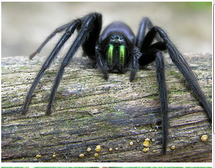Embark on a thrilling journey into the perilous world of serpents with 'Deadly Beauties: The Top 5 Most Venomous Snakes.' 🚨🔥 Explore the mesmerizing yet dangerous realm of these lethal creatures as AI technology brings their captivating features to life. From the Inland Taipan's venomous potency to the sleek and deadly Black Mamba, join us in unraveling the mysteries of these remarkable reptiles. 🌿💀 Brace yourself for a venomous adventure and gain a newfound appreciation for the beauty and danger these serpents hold. 🎥🔍 Don't forget to like, share, and subscribe for more captivating wildlife content! #DeadlyBeauties #VenomousSnakes #WildlifeExploration 🌐✨
The Inland Taipan
The Inland Taipan, scientifically known as Oxyuranus microlepidotus, is a highly venomous snake native to the arid regions of eastern Australia. Often referred to as the "fierce snake" or "small-scaled snake," this species is recognized for possessing the most toxic venom of any snake in the world. Despite its potency, the Inland Taipan is relatively elusive and has a reclusive nature. It primarily preys on small mammals and birds, utilizing its potent neurotoxic venom to incapacitate and subdue its prey. The snake's scales display a range of colors, including olive, dark brown, and black, providing effective camouflage in its arid habitat. Conservation efforts are in place to protect this species due to its limited distribution and the potential threats it faces, in its natural environment. Despite its fearsome reputation, the Inland Taipan is not considered aggressive toward humans and will typically avoid confrontation when given the chance.
The Black Mamba
The Black Mamba (Dendroaspis polylepis) is a highly venomous snake native to the savannas and rocky hills of sub-Saharan Africa. Renowned for its exceptional speed, agility, and striking black coloration inside its mouth, this snake is considered one of the world's deadliest. With a potent neurotoxic venom that can cause paralysis and respiratory failure, the Black Mamba is known for its aggressive behavior when confronted. Despite its name, the snake's coloration ranges from olive to gray, with its intimidating name more accurately reflecting the inky black coloration of the inside of its mouth when threatened. The Black Mamba is a diurnal species that preys on small mammals and birds, and its remarkable speed makes it a formidable hunter and escape artist in its natural habitat.
Russell's Viper
Russell's Viper (Daboia russelii), found across South Asia, is a venomous snake known for its distinctive appearance and potent hemotoxic venom. Characterized by a triangular-shaped head, keeled scales, and a patterned body, this snake is often found in a variety of habitats, including grasslands, forests, and agricultural areas. Russell's Viper is recognized for its aggressive nature when threatened, coiling and hissing loudly before striking. Its venom contains a combination of cytotoxins and hemotoxins, causing severe tissue damage and clotting disorders. Despite the danger it poses, Russell's Viper plays a crucial role in controlling rodent populations in its ecosystem. Conservation efforts are essential to ensure the coexistence of this species with human populations and to mitigate the potential risks associated with its venomous bite.
The Saw-scaled Viper
The Saw-scaled Viper (Echis carinatus) is a venomous snake inhabiting arid regions of the Middle East, Central Asia, and parts of Africa. Known for its small size, distinctive saw-like keeled scales, and a series of scales that produce a rasping sound when the snake rubs them together, this species is highly adaptable to a variety of environments, from sandy deserts to rocky landscapes. Despite its relatively diminutive size, the Saw-scaled Viper is considered one of the most dangerous snakes due to its potent hemotoxic venom, which can cause hemorrhage and other severe symptoms. Often displaying a defensive posture with a coiled body and a striking pattern, encounters with humans can lead to potentially life-threatening situations. Conservation efforts are essential to address the impact of habitat loss and human-snake conflicts in regions where the Saw-scaled Viper resides.
Cobras
Cobras, belonging to the genus Naja, encompass various venomous snake species distributed across different regions of the world, each possessing its unique characteristics. The Indian Cobra (Naja naja), found in the Indian subcontinent, is renowned for its distinctive hooding display and neurotoxic venom. The Egyptian Cobra (Naja haje), native to parts of Africa, is recognized for its elegant appearance and potent venom. The King Cobra (Ophiophagus hannah), the world's longest venomous snake, inhabits Southeast Asia and possesses both powerful neurotoxic and cytotoxic venom. Cobras are characterized by their iconic hooding behavior, which they use as a defensive display when threatened. While these snakes are venomous and should be treated with caution, they are integral to their ecosystems, contributing to rodent control. Conservation efforts are crucial to protect these iconic serpents and address the challenges they face in their natural habitats.
















































